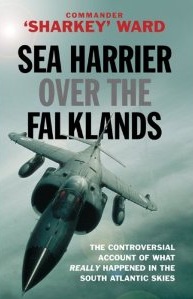No trudge novel but again a real ‘aviation book’ for the night table! In my search for good books that cause your heart beating faster, I bought ‘Sea Harrier Over The Falklands’ of Commander ‘Sharkey’ Ward. The book is about the use of the then brand-new Sea Harrier in the conflict around the Falklands in 1982. Really a book that I was loning for to encounter at the start of my aviation-book-reading-adventure! The book is written by the very dedicated squadron commander of 801 Squadron of the Royal Navy, which send two aircraft carriers in the direction of the south pole.

The story begins in England before the start of the war. It tells how the Sea Harrier was introduced and only the best pilots learned to fly at the Harriers. They really won dogfights with fighters from other NATO partners. Commander Sharkey helped with the introduction of the Harrier within the Royal Navy. After Margaret Thatcher decided that the Falklands realy belonged to the United Kingdom, she sent a fleet of ships, including two aircraft carriers (HMS Invincible and HMS Hermes) with Harriers off to the Falklands. The major part of the book takes place in the sky in the cockpit of a Harrrier and of course the 801 SQN aircraft carrier, HMS Invincible. Many details of how to fly a Harrier are discussed. The writer also discusses how to fight your opponents in and from the air.
The leading of the fleet was done by the higher command based on HMS Hermes. Sharkey was stationed on HMS Invincible with his squadron, so it was commuting between the ships to make plans and to outline the strategy. It soon became apparent that there were some disagreements regarding tactics including the management of the Harriers and their tasks. At that time only a few people knew what the Harrier was exactly capable of. What also became obvious was that the pilots of 800 Squadron from HMS Hermes used their Harriers and especially their radars ‘different’ (read less well and less efficient) than the pilots on the HMS Invincible. Especially these radars were crucial to discover enemy aircraft or ‘boogies’.
Once at the Falklands arrived, the book describes several missions of ‘Sharkey’ and other pilots. Extensively written down is also the security of the fleet and the use of the Search and Rescue (SAR) helicopters. I found it interesting to read how the system works to protect ships against enemy missiles. One part of that system is the Phalanx system, named after the square array of soldiers with their spears at the time of the Romans.
About the security, and in particular the protection and saving the lifes of the pilots in trouble, ‘Sharkey’ had a different opinion with one of his superiors. That caused some nasty problems for ‘Sharkey’ in the aftermath of the war. Interesting to read was also that the Navy cracked the missions from Asencion Island with Vulcan bombers, refuelled in the air by 12 Victor- tankers (see my book review of ‘Vulcan 607’)! The Navy found all those missions too expensive because of the large amounts of fuel burned and most important inefficient. It is nice to read about completely different insights and assessments of the missions of the Vulcan!
Commander ‘Sharkey’ flew over 60 missions in total, won 3 “air-to-air kills, and was a partner of a total of 10 ‘kills’. He was eventually awarded a Distinguished Service Cross (DSC) for bravery. Later also his son become a Harrier pilot.
Commander ‘Sharkey’ writes very interesting. It is an easy to read book that offers a revealing glimpse behind the scenes of the Royal Navy operation in the 80’s. The whole story reads like an exciting boys’ book. The book contains photos that make it easier to feel empathy for the situation at that time. The book is a real ‘page turner’. After reading the book I wanted to join the ‘Sharkey’-fan club but there isn’t one unfortunately!
More info on http://www.sharkeysworld.com ,http://en.wikipedia.org/wiki/Nigel_Ward and also see http://www.youtube.com/watch?v=bpeQOOal1cg&feature=related
Interesting film (part 4 of 6) with an interview of ‘Sharkey’.












Leave a Reply